Paesemuseo: about locality as a specific platform and an abstract object of investigation
Written by Susanna Schoenberg
In 1968 Pinuccio Sciola, sculptor and (becoming) father of Sardinian muralism, started a mobilization process of his community; one year later his village San Sperate was declared to become a museum, anticipating the contemporary discourse on contextual or site-specific art. Noarte Paesemuseo is actually the art (and artists) association in charge of this locality tradition.
2009 I was asked the first time to develop a collaboration idea with the local platform in order to locate an international workshop for young artists in San Sperate, and to “use” the community, its sites and modalities of action as an object of (post-colonial) investigation.
The paper is striving to reconstruct the development of the local art platform and its vocation as a playground for site-specific research and intervention. In particular it focuses the aspect of the platform operating as a laboratory, providing infrastructure, narratives, operators but also subjects and phenomena to be experimentally examined. Features of the category of an acting “locality”—in the sense of a local-player, an agent model temporarily applicable on the specific fields of cultural work and cross-cultural communication—are expected to get delineated and emphasized.
The museum-village
The call for a village to become a museum can evoke some attitude of preservation or even touristic reallocation of material and cultural values of a site and its community. The mediation around the formula of Paesemuseo of course included and still refers to some aspects of this kind of attitude. The village is always object to be categorized, reflected and exhibited, but it is primarily the context of everything to be shown. Furthermore the village is not only the site, the container of the exhibition, it is exhibitor and purchaser in one.
Locality as an agency
As a label Paesemuseo defines today a (local) agency addressing locality as an audience (and clientele) and giving commission to (external) artists expecting them to i) become engaged with locality in terms of local traditions and narratives, and ii) expand the locality competence as an audience and an actor. Alternatively locality is establishing itself as an art commissioner, an art operator involved in production, a context giving instance for contextual art, a narrative or material source for artistic projects.
From the very beginning Paesemuseo was noticed for its intent to widen the (local) audience for art but also for other discourses. When witnesses and participants of early activities of Paesemuseo have to rethink of the history of their own movement, they first refer to the French May protests of 1968 witnessed by Pinuccio Sciola in Paris.
The emancipation of the one—the young Pinuccio Sciola traveling for becoming an artist—is the origin of the contextual question. Back home the artist found a peer group interested in the use of art practice as a social one: some of the involved young men were quoted talking of “riscatto”, something which sounds like ransom, disembarrassment and reparation. The activities of Paesemuseo were seen as actions for buying themselves free, in order to compensate some traditional subjugation but also to emancipate as autonomous subjects (part of an autonomous locality).
This is the language of the late 1960s and mid 1970s. The corresponding visual and performative language characterizing the first actions of Paesemuseo refers to an (imagined) imaginative universe of “servants”: beginning with the whitening of the uncooked walls of the village before the procession of Corpus Christi (May/June 1968), the following sessions of mural painting (1969-1978)[1], and the placing of a plow as a sculpture in public space, which the village mayor tried to get removed without success (1975).
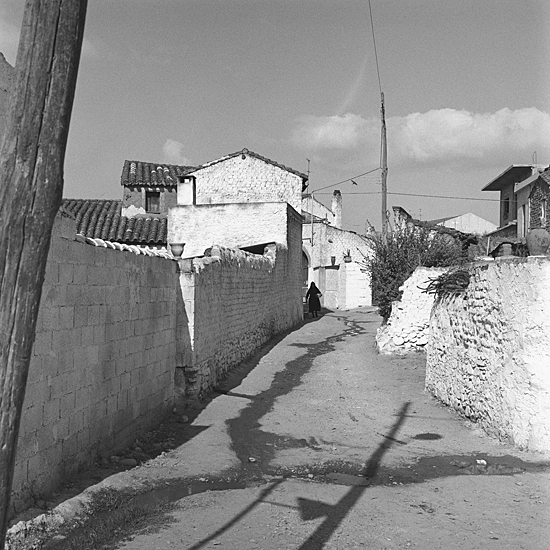
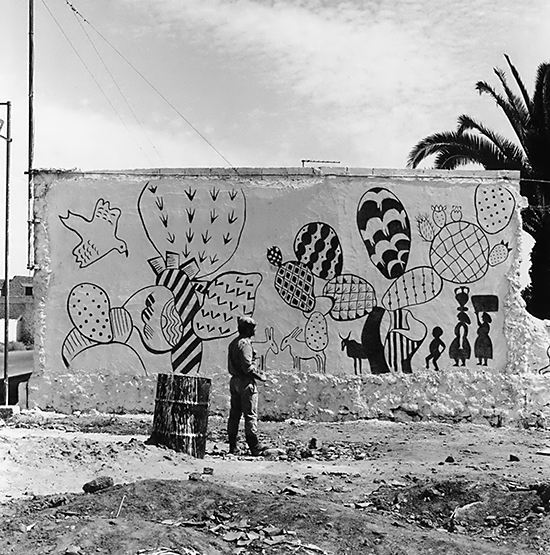
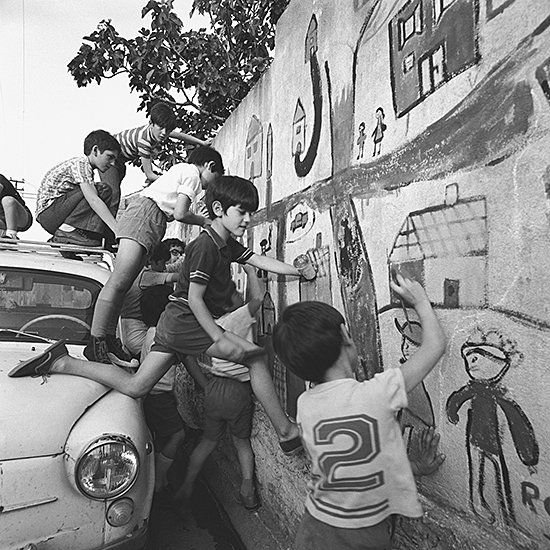
From its outset Paesemuseo is willing and capable to get artists involved: from the island Sardinia, the so called Italian continent, Central Europe and Mexico. The presence of international artists has always played an important role in the narratives concerning Paesemuseo: the local press, the local historians, the community itself, are used to point out the existence of supporters from abroad, of some kind of international resonance. As a platform Paesemuseo not only induced the involvement of the local community but also an open call for projects, a call for individual expression expected to be able to relate to the implicit idea of an autonomous (communitarian) museum. A contextual enlargement for art practice in relation to a communitarian mandate: this could have been the formula behind a virtually ongoing open call for participation.[2]
Every human being is an artist (but an artist is an artist)
Joseph Beuys did not literally mean that every human is or should be a painter or a sculptor,[3] at the same time the development of the activities around Paesemuseo are interesting exemplifications of how local artists and other local players were leading the contextual enlargement of art in the sense of Beuys' vision. Paesemuseo always manifested aspects of a Soziale Plastik. The idea of participation in art projects or actions of transformation derived from art practices is ideally connected to an idea of sculptural (social) transformation acted by individuals (as part of the community). Certainly this is also the result of the ambition of context enlargement the artist Pinuccio Sciola operated for his own oeuvre. He practiced appropriation—of issues, motifs, language, techniques—, and designed with his actions an experimental environment, where unplanned things could happen.[4] He was finally identified as the maker of the social sculpture Paesemuseo. Pinuccio Sciola managed to participate in the Venice Biennale of 1976 with a sculptural intervention on the San Marco square which included the presence and involvement of a group of Sardinian artists and activists of Paesemuseo.[5]
Locality meets Decentralization: the practice of barter
During the 1970s the idea of cultural decentralization is mobilizing some European scene. Artists abandoning the centre of cultural production—the central educational institutions and the established stages or exhibition spaces—are looking for decentralized audiences. In January 1974 the Odin Teatret, founded in Norway by Eugenio Barba and later based in Denmark, reached Orgosolo, Sardinia. The legend tells that it was a spontaneous situation which generate the practice of barter, for which the theatre group will become famous. The group performed a piece in front of an audience of 60 persons; at the end the audience asked for explanations, but the director told them that they are supposed to decide for themselves what the piece is about. In answer to that the audience performed a program of local dance and music as a service in return. The practice of barter points out some interesting aspect about cross-cultural exchange: it works on the level of activity—of being an active cultural operator—and almost excludes the aspect of reception due to translation:[6] “There is anything I can understand. The Danish actors are only showing what they can do. So I will show them what I can do and they have no clue about”.[7]
The group leaded by Barba visited San Sperate more times between 1974 and 1975 and practiced there barter of theater. During one of the visits of 1975 they performed a funeral procession in solidarity with Paesemuseo protesting against the municipality intended to stop muralism.
The barter between strangers has been one of the technical motives of the first collaboration with Paesemuseo I have been engaged in; not really prepared to respond to the expectation of activating (local) identity of their hosts, the group of young artists flown in from Germany came with a methodological need of estrangement in order to perform observation and site-specific interventions. [8]
Most of the realized projects implied collaboration with locals. One in particular implemented collaboration and barter of competences as a central art motif. Aino Korvensyrjä called herself an “anthropologist-artist” and her project a “photographic-agricultural collaboration”.[9] The exchange between the two forms of work—the work on the field and the artistic work of its representation—should be seen in a contemporary social set-up where “what we call work is increasingly an observing activity”. In that sense the barter of competence between the farmer Piero Murgia directing the artist in harvesting artichokes, and the artist teaching the farmer in shooting photographs documenting and staging the artist's work on the field, is an exchange between “equivalent” forms of “real” work.
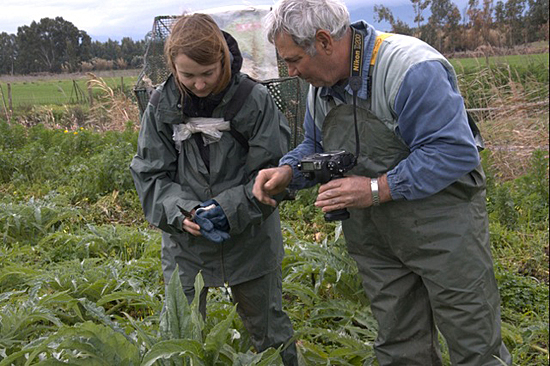
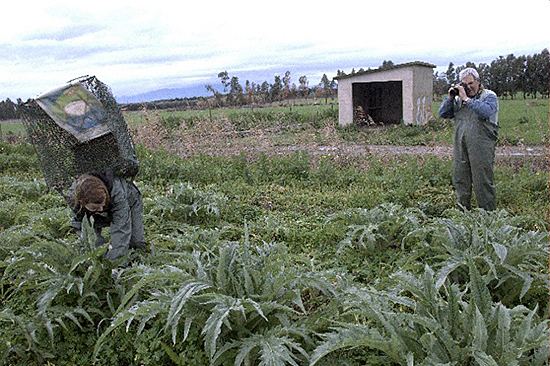
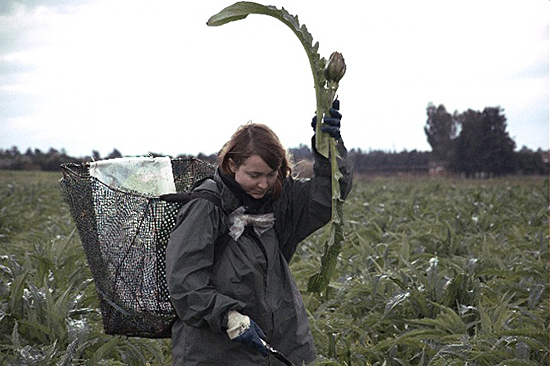
Offers of education and appropriation as a matter of work
An implicit idea of an educational offer for young international artists—in terms of inspiration, esthetic tradition, competence in material practice— was an evident aspect of the communitarian mandate of Paesemuseo as I experienced it in 2010. In my perspective the idea of an agency of (cultural) intermediation was interesting for its potential of providing access and supporting infiltration: the territory was the matter of work, something which sounds more abstract than a community or a traditional communitarian identity. To interact on the level of locality let me presume some high degree of autonomy (in decision-making) and sovereignty (in providing access). From the very first intervention platform on which I have had the possibility to realize with and for Paesemuseo, I accessed situations and institutional entities, observed processes, participated in negotiations.
Significant motifs of the “educational program” I designed as an artist and curator in-residence have been the perimeters of restricted or dissolving areas, such as an occupied factory and a military base. In the meantime both closed down and belong now to a long list of archeologic sites and unused infrastructures of a stratified territory molded and warped by several colonialisms.
It is my experience, and not only my methodological preference which enables me to argue that the real kernel what Paesemuseo is capable to offer, is to practice the contextual enlargement (of art) through acts of appropriation. One of the most fascinating object of possible appropriation I identified in my first visit to San Sperate was the municipal system of public announcement made by megaphones, which was still placed but out of work. At that time the administration had already developed a digital follow-up system distributed by modems, which was finalized but not in use because of the incompatibility with the newest national reglementation of open wifi-networks.[10] Since then I repeatedly realized actions of amplifications of contents using public devices, megaphones of churches, displays and megaphones of municipalities, (parasitic) radio transmitters and (registered) radio stations. When in 2011 I asked the local police for permission to use the public announcement system of the city of Buggerru—a former miners foundation in the province of Carbonia—it was a municipal employee who performed for me, reading excerpts of a communication published in 1977 by the Italian National Institute for Social Security in concern of the rules of retirement for mining workers. Before starting reading she voluntary informed the potential audience about the “cultural reason” of the announcement to follow. The amplification system was loud but intermittent. So listeners on the street—mostly individually, beside her car, or her dog, with a phone in her hand– took part in this line-up of an audience with only partial and variable information. (I remember it as one of the most poetic choreographic situations I have ever taken part in).
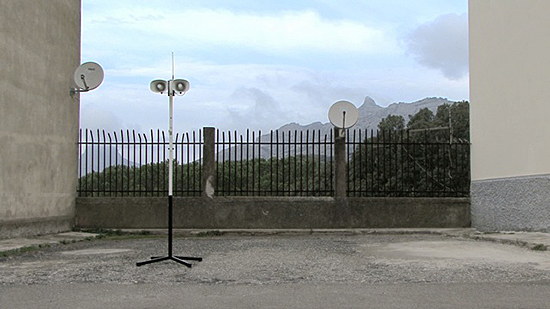
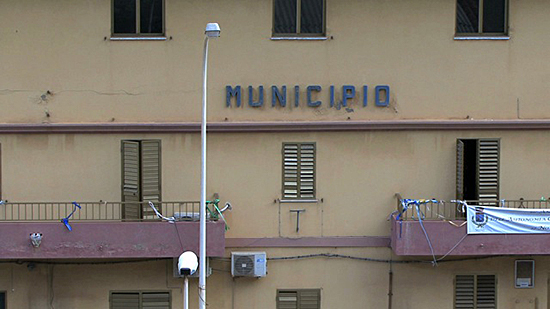
Communitarian assignment today
One representative implementation of Paesemuseo as an art production agency in recent years[11] is based primarily on participation: in becoming purchaser, designer and maker, being at the same time part of the subject of representation. After a theatre performance for which a street was painted blue, and an action with children who drew on some whitened streets of the village (both in 2007), the association Noarte developed a project for the municipality of San Sperate called Colore Identità.[12] The final result of the intervention was to color the streets of the old village center, but the core idea was to keep involving the population in the project realization, not only in terms of participation in a creative process, but above all in terms of activating the issue of identity through an approach of environmental psychology. Colore Identitá held laboratories in local schools—introducing the concept of the becoming intervention, the value of intervention and participation in general, the basics of a psychology of colors—, workshops with young architects—developing the plan of intervention—, and meetings with the villagers—discussing the plan of intervention. The choice of colors was made respecting the chromatic preferences of the residents. A functional differentiation in the use of colors reflected urbanistic improvements and the facilitation of socialization. Pinuccio Sciola made the final touches to the work by placing stone sofas on a public square: the village living room.[13]
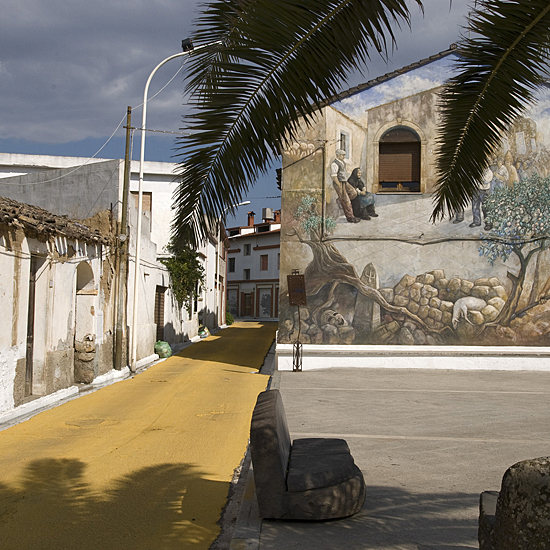
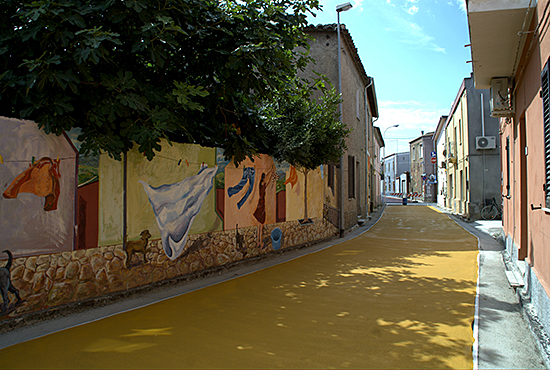
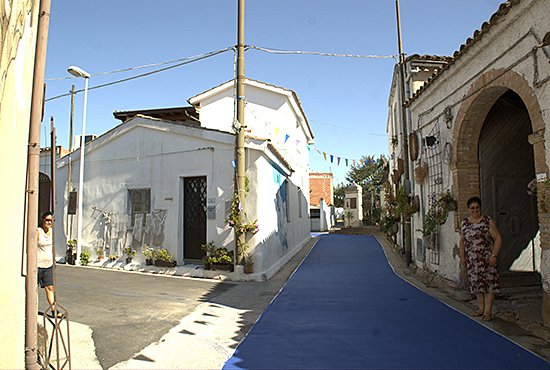
The actual course of Paesemuseo is highly focused on the assignment of generating locality and mobilizing an autonomous cultural discourse. How can this assignment meets the needs and the sensibility of a visiting artist, possibly cosmopolitan-oriented? In fact the implicit call for artists is not limited to participatory art. But because of the participatory mission of Paesemuseo most of the productions-in-residence are predestined for involving members of the community, their individual competences, or even institutional positions.
Even just the pure artist's perception of the context-giving assignment can generate a positive recognition factor in the hosting audience. Johanna Steindorf developed in 2012[14] her first virtual audio-walk based on the Google Street View representation of San Sperate. As she stated, the video Present Views on Past Streets
“was created from a first impulse or a desperate question on my part, how to do a work for a place I had never seen before. In this sense, I already understood this as a kind of assignment from and for the place, which was completely unknown to me until that moment.”
She visited the site virtually, designing a route, orienting her self through a space being in its past, commenting what she was observing. In fact she used this “intimate” encounter with her customer as a material to be shaped, including by chance references to the context-giving tradition:
“The fact that the walls of the village were designed by different artists was an added interesting aspect that could be taken into account using Google Street View. At the beginning, however, I wasn't really aware of its importance, nor was I aware of the fact that the video would also present paintings!”
The poetic of the concurrency of different time-layers and spacial realities experienced by the artist when she walked the designed route for real, was easily transferable to the video and its spectators. This evidence of a mixed-memory[15] touched the audience addressing strangeness and identity as would they talk the same language.
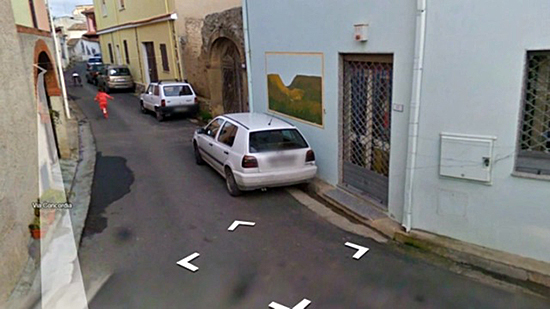
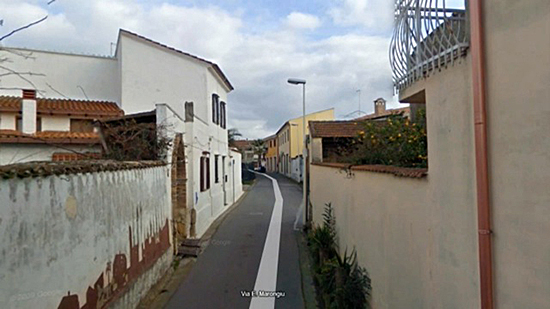
One of the implications of defining locality as ordering part in a contract for cultural work is the voluntarily (self-)reification of locality as a thing to be observed and represented, eventually to be surprisingly (re-)designed: not the least interesting object of investigation an artist (researcher) can imagine, against the background of the actual crises of both state and politics, which eventually become visible in some renewed movements of localisms and regionalisms, and in the denunciation of some transnational undemocratic mode of action of so-called global players of economy, finance and resources exploitation. Connectivity, interactivity, and acting as (variable) minority: these are also strategies which can be tested with/for/on locality as an agency for art.
[1] Gli anni della calce e il Paese Museo (The years of chalk and the museum-village) published in 2012 is an autobiographic narration retracing the original muralism movement in San Sperate. The author Cenzo Porcu is dating this period between May 1968 and December 1978.
[2] The operationalization of such a formula isn't unique. During 1970 a working group of artists and architects from Germany, Switzerland and the Netherlands trying to implement their ideas both on contextual enlargement and communitarian mandate in collaboration with Paesemuseo, gave up their project. In an open letter to Paesemuseo they deplore a poor communication with the population, and a small interest from the locality in both their pedagogic ideas and their focus on urbanistic priorities. The interruption of this specific collaboration and the analysis included in its announcement can be interpreted as expression of conflicting expectations also inside the local initiative called Paesemuseo.
[3] See Joseph Beuys, Every Man an Artist: Talks at Documenta 5, 1972 and Joseph Beuys, I'Am Searching For Field Character, 1973/74.
[4] 1971 The International Association of Art (working in official partnership with Unesco) addressed a letter of congratulations to Pinuccio Sciola for his activities in San Sperate. At that time the association expressed interest in proposing to candidate Paesemuseo, the village San Sperate and the local children painting murales on public walls for becoming Unesco World Heritage.
[5] Mario Faticoni, Sardinian theatre director and actor, reports they have been installing sculptures representing dead bodies and reeds as expression of the Sardinian condition. The spacial intervention included performance: of traditional music, body and gesture performances, handbills spreading and exchange with the public.
[6] „A BARTER revitalises the bonds of a professional, religious, ethnical or random community, inducing the feeling of a shared identity versus the 'foreigners' - the actors and their culture“. Quoted from the Odin Teatret official website: http://www.odinteatret.dk/events.aspx
[7] See Fabio Acca, Alle origini del baratto: l'Odin in Sardegna 1974-1975, in: Antropologia e Teatro. Rivista di Studi, 2013
[8] I'm referring to the seminar hold by art historian Stefanie Stallschus and myself at the Academy of Media Arts Cologne invited to join a period of production residency in San Sperate in 2010.
[9] See Susanna Schoenberg, Stefanie Stallschus, Feldforschung auf Sardinien, in: off topic #2, 2010
[10] The so-called Pisanu Decree of 2005 referred to the "struggle to international terrorism". It established both the obligation for Internet access providers to identify users and that of keeping data relating to operations made by them.
[11] When with the new millennium the activities of Paesemuseo were restarted after an interruption of almost 20 years, all the cards of a paradigm of action had to be drawn again. In 2000 Pinuccio Sciola relaunched the communitarian issue with an action of clear appropriation: all the collection pieces of the Louvre Museum were displayed (as replica) on the walls of the museum-village. Similar exhibitions followed: as visualizations of a recurring intent to bring the “academic” art into the community and to open a wider perspective on art. For the 40th anniversary of Paesemuseo in 2009 a bigger event was planned under the title “Beyond murales”. Responsible for these initiatives has been the association Noarte Paese Museo newly founded in 2001 and officially registered in 2005.
[12] The project was realized 2010-2013 with the support of the departments for Architecture of the universities of Cagliari and Ferrara.
[13] Noarte Paese Museo, Colore Identità – Valorizzazione del centro storico di San Sperate, 2013
[14] The artist was invited to participate in an International artist contest called Spazio Vitale (Vital Space) which took place in San Sperate as a collaboration with other Italian art associations.
[15] „The process was unique in the moment when I first came to the place I had chosen as the starting point for the video in San Sperate: Suddenly standing there shook me for a short moment. Because I noticed at that point that I actually already knew the city. Nevertheless, the proportions, distances, acoustics and climate did not correspond to what I had expected. This simultaneous contrast and concordance between expectation and reality was very strong at this point. Both moments - the Google-Street View walks and the experience on site - are still mixed in my memory.”











